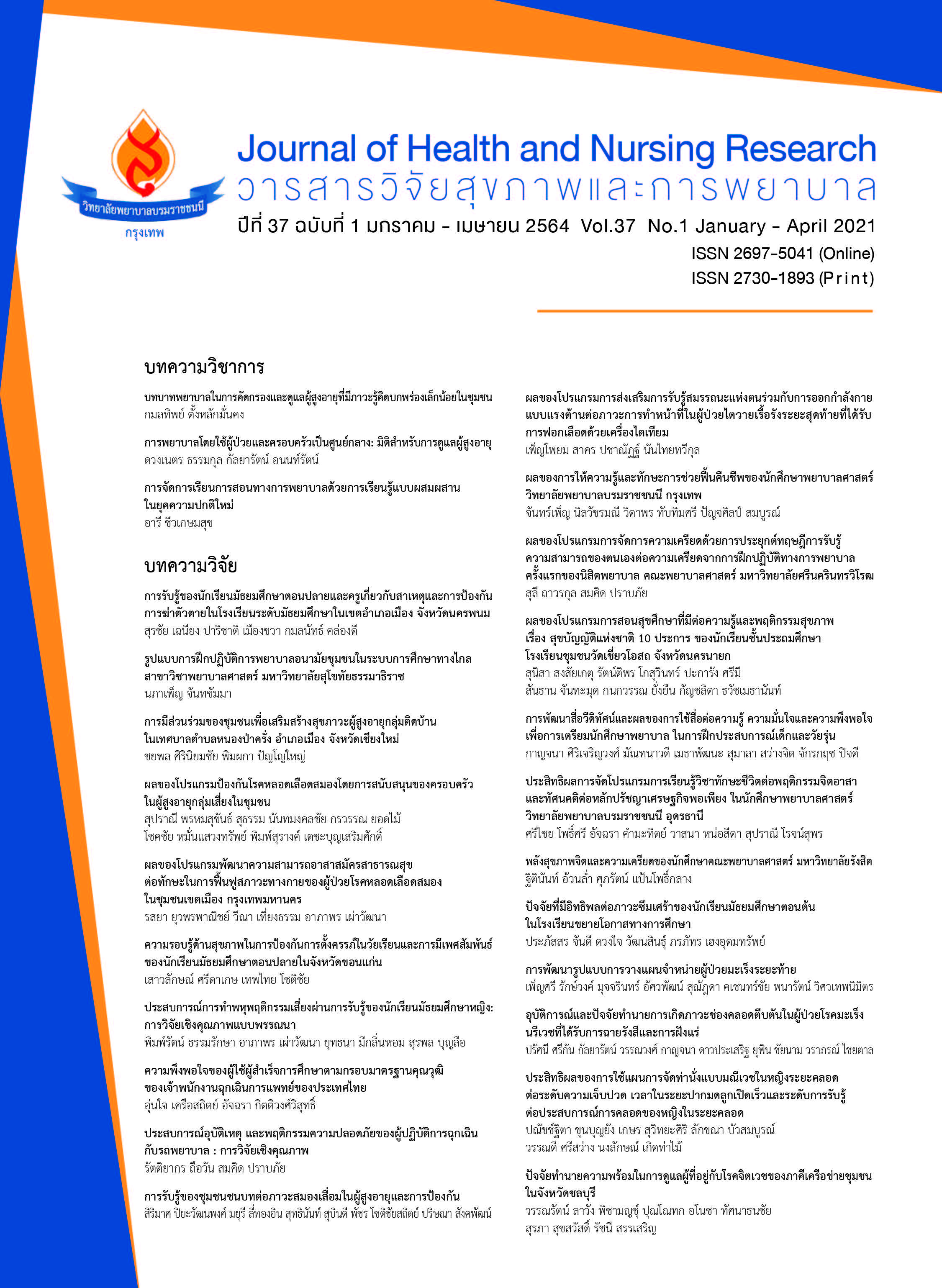การพยาบาลโดยใช้ผู้ป่วยและครอบครัวเป็นศูนย์กลาง: มิติสำหรับการดูแลผู้สูงอายุ
คำสำคัญ:
ผู้ป่วยและครอบครัวเป็นศูนย์กลาง, การพยาบาล, ผู้สูงอายุบทคัดย่อ
บทนำ: การดูแลโดยใช้ผู้ป่วยและครอบครัวเป็นศูนย์กลาง เป็นแนวคิดที่ให้ความสำคัญกับครอบครัวและผู้ป่วย ซึ่งมีความเหมาะสมกับยุคที่มีผู้สูงอายุจำนวนมาก เป็นการสนับสนุนให้ครอบครัวมีส่วนร่วมหรือเป็นหุ้นส่วนในการดูแล ทำให้เกิดผลลัพธ์ที่ดีต่อการดูแลสุขภาพผู้สูงอายุตามลำดับของความสำคัญและคุณค่าที่ผู้ป่วยและครอบครัวยอมรับ วัตถุประสงค์: บทบาทของพยาบาลในมิติของการดูแลที่เน้นครอบครัวเป็นศูนย์กลางต้องมี 1) ความรู้ครอบคลุมในศาสตร์ของการพยาบาลครอบครัว และการพยาบาลผู้สูงอายุ 2) ประยุกต์ใช้กระบวนการพยาบาลเพื่อวางแผน ปฏิบัติการพยาบาลและประเมินผล เน้นการมีส่วนร่วมของครอบครัวและผู้สูงอายุ 3) ให้ความรู้ครอบครัวและผู้สูงอายุในการเฝ้าระวังและการปฏิบัติตัวเมื่อเกิดกลุ่มอาการที่เป็นปัญหาเฉพาะหรือพบบ่อยในผู้สูงอายุ (Geriatric Giants หรือ Geriatric Syndrome) 4) สนับสนุนการสร้างเครือข่ายครอบครัว เพื่อการแลกเปลี่ยนข้อมูลข่าวสารและแหล่งประโยชน์ที่สนับสนุนการดูแลผู้สูงอายุ 5) พัฒนารูปแบบการดูแลผู้สูงอายุโดยใช้ครอบครัวเป็นศูนย์กลาง เพื่อตอบสนองต่อการเปลี่ยนแปลงของครอบครัวและผู้สูงอายุที่มีความซับซ้อนเพิ่มมากขึ้น 6) ประสานความร่วมมือกับทีมสหวิชาชีพ เพื่อแก้ไขปัญหาร่วมกันอย่างเป็นระบบเกิดประโยชน์สูงสุดในการดูแลผู้สูงอายุ และ7) เสริมสร้างความเข้มแข็งแก่ครอบครัว มิติการดูแลผู้สูงอายุปกติ หรือที่มีโรคประจำตัว ประเด็นสำคัญ: พยาบาลควรให้ความสำคัญในการส่งเสริมสุขภาพของผู้สูงอายุและครอบครัว ฟื้นฟูสภาพความเจ็บป่วย และการป้องกันโรค สำหรับมิติการดูแลผู้สูงอายุที่เจ็บป่วยเรื้อรังและเกิดภาวะวิกฤตที่ต้องพึ่งพาครอบครัวในทุกระยะของการดูแล สรุป: พยาบาลควรส่งเสริมความแข็งแกร่งของครอบครัวและผู้สูงอายุในการตอบสนองต่อการรักษาพยาบาล และฟื้นฟูสภาพความเจ็บป่วย อย่างไรก็ตามครอบครัวที่มีบุคคลอาศัยอยู่หลายช่วงวัย หากมีคนป่วยย่อมส่งผลต่อบุคคลอื่นที่อยู่ในครอบครัวได้ ข้อเสนอแนะ: การดูแลโดยใช้ครอบครัวเป็นศูนย์กลาง มีปัญหาซับซ้อนที่พยาบาลต้องใช้กลยุทธ์และความรับผิดชอบในการดูแลด้วยความใส่ใจ และให้ความสำคัญในการประเมินสภาพผู้ป่วย ป้องกัน ส่งเสริมและบริหารจัดการสุขภาพให้สอดคล้องกับภาวะเจ็บป่วย เพื่อทำให้ผู้สูงอายุอยู่รอดและใช้ชีวิตในขณะเจ็บป่วยกับสมาชิกในครอบครัวอย่างมีความสุข
Downloads
เอกสารอ้างอิง
2. Kokonya A, Fitzsimons V. Transition to long-term care: Preparing older adults and their families. Medsurg Nursing 2018;27(3):143-8.
3. Warner G, Stadnyk R. What is the evidence and context for implementing family-centered care for older adults?. Physical & Occupational Therapy in Geriatrics 2014;32(3):255–70.
4. Moyle W, Bramble M, Smyth W, Beattie E. ‘They rush you and push you too much and you can't really get any good response off them’: A qualitative examination of family involvement in care of people with dementia in acute care. Australasian Journal on Ageing 2016;35(2):E30-E34.
5. Rosenbloom-Brunton DA, Henneman EA, Inouye SK. Feasibility of family participation in a delirium prevention program for hospitalized older adults. Journal of Gerontological Nursing 2010;36(9):22-33.
6. Chun-Gill K, Soon KM, Hee LY. Experiences of family caregivers utilizing care support of dementia center. Korean Journal of Adult Nursing 2018;30(3):314-24.
7. Sacan S, Adibelli D, Akyil RC. Old age from children's perspective. Children and Youth Services Review 2020;109:104714.
8. Institute for patient- and family-centered care. What is patient- and family-centered care?. [Internet]. 2020 [cited 2020 April 1] Available from https://www.ipfcc.org/.
9. Aubertin-Leheudre M, Rolland Y. The importance of physical activity to care for frail older adults during the COVID-19 pandemic. Journal of the American Medical Directors Association 2020; Journal Pre-proof, doi: https://doi.org/10.1016/j.jamda.2020.04.022.
10. Jong-udomkarn D. Family practice nurse: Competency and experience in teaching and learning management. Document for academic conference "Innovative development for advanced nursing practice for family nurses"; 2010 June 17-18; Faculty of Nursing, Khon Kaen University; 2010. (in Thai).
11. Park M, Giap TT, Lee M, Jeong H, Jeong M, Go Y. Patient- and family-centered care interventions for improving the quality of health care: A review of systematic reviews. International Journal of Nursing Studies 2018;87:69–83.
12. National Statistical Office. Press conference "What does statistics tell? Elderly present and future". Bangkok: Public relations news, National Statistical Office; 2018. (in Thai).
13. Pradubmuk-Sherer P, Wongyai N, Chareensukploypol B. Social protection network: Social immunity for the elderly. Department of Social and Health, Faculty of Social Sciences and Humanities, Mahidol University; 2014. (in Thai).
14. Wright LM, Leahey M. Nurse and families: A guide to family assessment and intervention (5th ed.). Philadelphia: F. A. Davis; 2009.
15. Phalasuek R, Thanomchayathawatch B. A family model for older people care. The Southern College Network Journal of Nursing and Public Health 2017; 4(3):135-50. (in Thai).
16. Department of Health Service Support, Ministry of Public Health. Elderly health. Nonthaburi: War Veterans Organization of the House; 2019. (in Thai).
17. Gadudom P, Apinyalungkon K, Janjaroen K, Wae N. Family roles to increase quality of life of older persons in a changing situation. The Southern College Network Journal of Nursing and Public Health 2018;5(3):300-10. (in Thai).
18. Yotthongdi N, Sunthornchaiya R. Factors related to hopelessness of elderly patients with depressive disorder and physical illness. Journal of Boromarajonani College of Nursing, Bangkok 2017;33(1):29-39. (in Thai).
19. Namjuntra R. Patient and family-centered care: a challenging health service model. Journal of the Nursing Council 2009;24(1):5-10. (in Thai).
20. Garrouste-Orgeas M, Willems V, Timsit J, Diaw F, Brochon S, Vesin A, et al. Opinions of families, staff, and patients about family participation in care in intensive care units. Journal of Critical Care 2010;25:634-40.
21. Buckley P, Andrews T. Intensive care nurses’ knowledge of critical care family needs. Intensive and Critical Care Nursing 2011;27:263-72.
22. Safak T, Emektar E, Safak Y, Kan E, Corbacioglu SK, Cevik Y. Comparison of social supports for geriatric patients admitted to emergency department for trauma and medical reasons. Turkish Journal of Emergency Medicine 2019;19:96–9.
23. Namasivayam-MacDonald AM, Shune SE. The influence of swallowing impairments as an independent risk factor for burden among caregivers of aging parents: A cross-sectional study. Geriatric Nursing 2020;41:81-8.
24. Andruszkiewicz G, Fike K. Emerging technology trends and products: How tech innovations are easing the burden of family caregiving. Journal of the American Society on Aging 2016;39(4):64-8.
25. Sun V, Raz DJ, Kim JY, Melstrom L, Hite S, Varatkar G, et al. Barriers and facilitators of adherence to a perioperative physical activity intervention for older adults with cancer and their family caregivers. Journal of Geriatric Oncology 2020;11:256–62.
26. Jewpattanakul Y. Family nursing. Nakhon Pathom: Mahidol University; 2016. (in Thai).
27. Nichols A. The impact of the clinical environment on family centred care in the neonatal unit: a qualitative investigation. Journal of Neonatal Nursing 2014;20(5):230-5.
28. Fulmer T. A retrospective/prospective on the future of geriatric nursing. Geriatric Nursing 2020;41(1):29-31.
29. Burggraf V & Mueller C. Visionaries in geriatric nursing: A legacy for the future. Geriatric Nursing 2020;41:7-13.
30. Fongkerd S, Himananto S, Tantalanukul S. Family-centered care: From theory to practice for end of life care of critical patients in intensive care unit based on Thai context. Journal of Phrapokklao Nursing College 2016;27(Suppl):170-8. (in Thai).
ดาวน์โหลด
เผยแพร่แล้ว
รูปแบบการอ้างอิง
ฉบับ
ประเภทบทความ
สัญญาอนุญาต
บทความที่ได้รับการตีพิมพ์ เป็นลิขสิทธิ์ของวารสารวิจัยสุขภาพและการพยาบาล (วิทยาลัยพยาบาลบรมราชชนนี กรุงเทพ) ไม่สามารถนำไปตีพิมพ์ซ้ำในวารสารฉบับอื่น


















